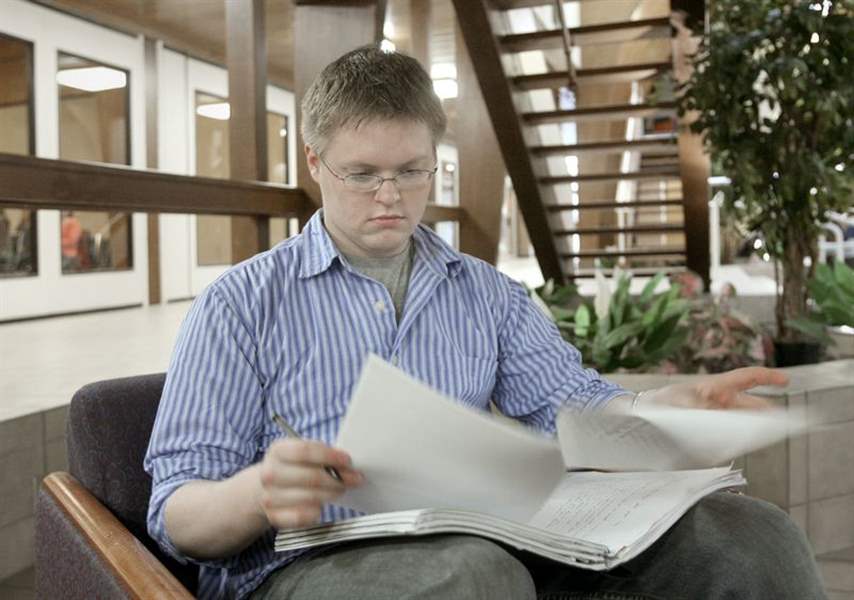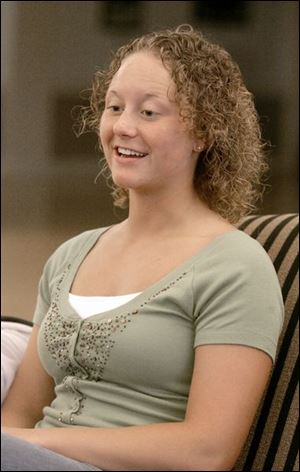
Students face possible loss of state funds
3/25/2007
Jason Wilch, a University of Findlay junior, says the loss of the state grant would not cause him to leave the school. I d come up with a way, but it would be more of a burden.
The Blade/Allan Detrich
Buy This Image

'A thousand dollars is a lot to lose,' says Danielle Goubeaux, a biology-premedicine major at Ohio Northern University.
COLUMBUS - Nearly 45,000 Ohio residents attending four-year private colleges instead of taxpayer-supported schools could lose as much $35.7 million in financial aid under Gov. Ted Strickland's proposed budget, the private schools say.
The students no longer would be able to count on a $900 check that arrives each year regardless of their families' income. The state would instead target a smaller pot of private school aid to those most in need.
"A thousand dollars is a lot to lose," said Danielle Goubeaux, a biology-premedicine major from Coldwater, Ohio. She said she looked at public and private colleges before settling on Ohio Northern University in Ada.
She's paying for her education and said she will probably have to borrow more to cover the loss of the Student Choice Grant.

Jason Wilch, a University of Findlay junior, says the loss of the state grant would not cause him to leave the school. I d come up with a way, but it would be more of a burden.
In his State of the State Address, Mr. Strickland lumped this change in with other proposals that choose public institutions over private.
He called for the elimination of Ohio's statewide voucher program helping parents with youngsters in failing K-12 schools to pay tuition at private schools. He also asked lawmakersto eliminate aid for students at for-profit career colleges whose degrees aren't recognized by the Board of Regents.
While Mr. Strickland has proposed reducing the choice grant program that exclusively benefits state residents choosing private colleges, many still would benefit from an already mapped-out expansion of another financial-aid program that benefits students at both public and private institutions.
The governor also called for increased state support for public universities in exchange for promises they would freeze tuition next year and raise it no more than 3 percent in 2009.
![Students-face-possible-loss-of-state-funds-3.jpg If [the cut] happens in the fall, we ll really be in a dilemma, says Ohio Northern University President Kendall Baker.](/image/2007/03/25/300x_b1a4-3_cCM/Students-face-possible-loss-of-state-funds-3.jpg)
If [the cut] happens in the fall, we ll really be in a dilemma, says Ohio Northern University President Kendall Baker.
"It's simply a matter of making priority choices, and the overall goal of the administration is to increase the number of students who are in higher education, both public and private," said Ohio's new higher education chancellor, Eric Fingerhut. "The surest way to do that is to make college affordable for as many people as possible. We need to focus available aid dollars on those in financial need."
Under the choice grant program, the state provides grants of $900 to more than 58,000 students at roughly 50 private schools, including the likes of Case Western Reserve University in Cleveland, Xavier University in Cincinnati, Heidelberg College in Tiffin, and Lourdes College in Toledo.
"We know they will lose the money," said C. Todd Jones, president of the Association of Independent Colleges and Universities of Ohio. Members include most of the private, four-year colleges in the state.
"It's a question of whether [the students] will leave the school, choose to move to a neighboring state, or choose not to go to college entirely," Mr. Jones said. "Toledo is a great example of that. Right now the cost of attending Lourdes College and the University of Toledo is about the same. If this [grant] disappears, some [Lourdes] students may drive across the border to Michigan."
He said private schools would lobby the Republican-controlled General Assembly to restore the funding.
While the choice grant program would be downsized from $52.9 million this year to just under $18 million, the Democratic governor plans to stick with an existing plan to broaden the Ohio College Opportunity Grant program. That need-based program would help roughly 100,000 students at public and private schools.
The program considers a family's assets and other need factors when determining the size of grants.
The governor's budget also would not interfere with the current practice under that program of doubling grants for students choosing private schools over public, a recognition that such schools get little taxpayer help while playing a significant role in educating Ohioans.
It's also recognition, said Mr. Fingerhut, that tuition at private schools is, on average, much higher than that of taxpayer-supported schools such as the University of Toledo and Ohio State University.
"Sending $900 to every student regardless of whether that makes a difference in the choice of school or ability to go to school is a classic peanut-butter scenario," Mr. Fingerhut said. "You can send $900 to everybody or you can focus on where you can really make a difference."
The private college association estimates that 1,979, or 82 percent, of full-time students receiving the $900-a-year grants at Ohio Northern University will no longer qualify under Mr. Strickland's proposal. The $1.6 million lost by Ohio Northern students would have to be made up by families digging deeper into their pockets, borrowing more, or finding other financial aid.
ONU President Kendall Baker said the governor's proposal could prompt students to opt for a public universities instead, ultimately helping to increase pressure for state support in that area. Or they could go out of state, risking the possibility they may never return.
"If [the cut] happens in the fall, we'll really be in a dilemma because we've already prepared thousands of financial-aid packages that include that $900 grant," Mr. Baker said. "We're already getting questions from families, and we'll get more."
ONU's tuition is $29,403 a year, compared to $7,929 for in-state undergraduate tuition at taxpayer-supported UT.
At the University of Findlay, 1,702, or 88 percent of current grant recipients, are expected to lose almost $1.4 million.
UF President DeBow Freed said this would not make or break the school of 3,300 undergraduate and 1,200 graduate students, but it could impact individual families.
"It's critically important for families who have made the choice to have their children get the type of education that they want and they think would be most beneficial, " he said. "They make great commitments for it. They borrow. It's a family choice almost always, so it places an additional burden on the family."
UF's average tuition this year is $21,836.
Jason Wilch, a UF junior from a middle-income family who commutes from Upper Sandusky, said the loss of the grant would not cause him to leave the school.
"I'd come up with a way, but it would be more of a burden," he said.
UF provides financial aid to more than 87 percent of all undergraduates with an average financial aid package worth $15,654.
"There's no evidence that [losing the $900 grant] would impact the choice individuals make," Mr. Fingerhut said. "If you attend private school, an additional $900 is nice, but there's no evidence it would be the deciding factor."
Mr. Strickland's budget would increase annual spending on the broader-opportunity grants for students from lower and moderate-income families from $150.6 million to $182.5 million next year.
"There's a lot of savings by cutting the private [school] side, but where is that money going?" Sen. Randy Gardner (R., Bowling Green) asked. "The only thing that is happening is they are continuing what was already established in previous General Assemblies. My guess is most legislators would say there's nothing new in terms of greater accessibility for students."
The opportunity grant expansion would be accomplished by more than doubling the family income cap from $36,000 a year to $75,000. The maximum grant a student could get to attend a publicly supported school would climb from $2,190 to $2,496, a 14 percent increase.
The corresponding doubling of the award for a student opting for a private school would mean a student whose family meets the income criteria could receive up to $4,992, plus $900 from the scaled-back Student Choice Grant program.
Contact Jim Provance at:
jprovance@theblade.com
or 614-221-0496.